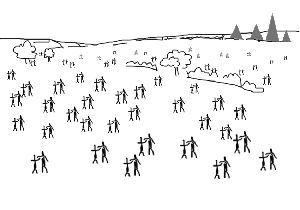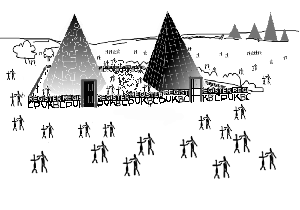'Next Steps' - to Happiness? ........play sound track
Reflections on the Psychological Therapies Reference Group Meeting 18th September 2007
Ipnosis left the Reference Group meeting at the BPS and headed towards Somerset House to see the Courtauld Institute's Adam and Eve Exhibition. And there I was reminded by the Cranach paintings of the special virtues of images in helping us appreciate hidden power relations, especially landscapes.
Patient and willing regulation watchers may recall that eIpnosis has been here before.
Eight years ago Ipnosis published a tiny series of drawings (right) that showed how the open prairie of UK psychopractice, happily populated by a sprinkling of practitioner/client dyads, had been damaged by the imperious fencing off of a sector of the prairie by the UKCP and BCP, over which they claimed possession/ jurisdiction. All in the name of client protection of course.
Inside the fenced off area of this gated community, pointy bureaucratic hierarchies had been erected and security systems installed to admit the professionalized righteous into the fold and to damn the charlatans to exclusion. Imaging such bizarrely incongruous domineering and bullying behaviour in this way was intended to feed resistance to this folly by practitioners who, if lacking in righeousness, were not so susceptible to being entranced as the inhabitants behind the wire.
This was the landscape of the Alderdice period. It was a seriously deficient picture as the noble Lord (and Ipnosis) found when he ignored the BAC, as it then was, in writing his Psychotherapy Bill. Yes the BAC, soon to be the BACP, was missing, so were the BPS and also the DoH.
What would such a landscape look like today?
Contributions at the September 18 Reference Group meeting pointed to a much expanded landscape. The fenced off section of prairie of the mainstream accrediting and training bodies is still there but it now resembles a slightly rundown industrial park protected by a security fencing and surveillance cameras. The pointy BCP building is still in place, and off to one side are the 80 sheds housing the UKCP's training enterprises; adjacent to them arise the regal columns of the BPS premises and nearby are the vast, touchingly half-timbered BACP premises. Adjacent to this industrial estate is a sparkling new industrial park from which is rising a high-tech, multi-storey block still crowned with cranes. A huge neon sign on the side of the building with the letters 'CBT' announces its ownership.
Some way in the distance, rising out of the plain, is a mist shrouded mountain range. Dotted around on it are a series of government fortresses whose worn stones testify to parliament's formative history of centuries of tribal conflict. The ancient stone towers are now festooned with satellite dishes, aerials and surveillance cameras that constantly scan the surrounding countryside and communicate with the other .gov fortresses.
The NHS castle, by far the largest of the collection, extends from some way up the mountain right down onto the plain. It is a motley collection of new office blocks and old refurbished barracks, and inflatable bouncy castles. It throbs with life. And of course, death. The hum of the NHS's industrial power can be heard everywhere. Oh yes, tucked into a corner of the NHS site is its own science park, housing the CHRE, NICE and SfH.
The country lane running between the old industrial estate housing the BPS, BACP, BPS and BCP and the government fortresses remains little used and has never been upgraded. However, trucks and bulldozers are at work on the foundations for a new road between the NHS site and the CBT industrial park.
If we zoom back a bit we can see, off to the right, another new feature in the landscape, yet another industrial park. Set in its own grounds and protected by a moat with a drawbridge, is a new stainless steel and glass building cunningly constructed in the form of a portcullis. It houses the HPC.
Some way out in the prairie are two adjacent communities: the psychoanalysts who live in a labyrinth of caves, the entrances to which are just visible; nearby is the IPN campsite a dazzling mix of caravans and tents
If we can accept this daft but I believe accurate enough picture of the state of play in our occupations of counselling, psychotherapy, psychology and psychoanalysis, what might be missing?
A valuable contribution to the September 18 Reference Group meeting was an outline by an insider of the projected growth of the government's programme for IAPT as a feature of this landscape. At present only two pilot schemes are in place, with what was described as derisory funding of £200K each. However, in what seemed a vitally important indicator, the person from inside the IAPT work revealed that 85% of the UK PCT's had bid for the two IAPT pilots and that eleven were shadowing the present development of it. Plus in Scotland, installation of IAPT was further advanced and its progress was being closely and widely watched. The view from the inside was that IAPT fits very well the global move in the NHS towards the commissioning of services, not least those devoted to mental health. Apply to be an IAPT 'Pathfinder' here, it is a remarkably brief form, even more remarkable Ipnosis feels, is the choice of the name itself, in WW2 Pathfinders identified targets for bomber squadrons!
Among other features of the IAPT initiatives is the notion of 'stepped care'. A troubled person showing up to see their GP will first be given 'books on prescription'—something to read or play on their computer. Depending the outcome i.e. do they stay away or come back, they may move on to actually meeting an entry level psychopractitioner, and could eventually gain access to intensive psychological therapy/medication etc. In organizations as large as the NHS, the biggest employer in Europe, with over a million employees, staffing such enterprises is a major managerial/human resources/training task and the language being used to describe IAPT reflects this. Recruitment/accreditation/regulation is expected to divide between 'high volume, low intensity' and 'low volume high intensity' service delivery'
What does this mean for our landscape of psychopractice?
The IAPT initiative promises to add a major suburb to the NHS. It may only be a plan at the moment but it is one which, because it fits the government's technocratic managerialist style and especially the move towards a commisioning structure, seems very likely to be built. In support of this guesstimate we should note that SfH are already building the NOS motorway between the IAPT suburb and the NHS (with a spur road to the HPC and the BABCP premises). And as a variety of comments at yesterday's meeting made clear, the NOS motorway entirely bypasses the psychopractice premises of UKCP, BACP, BCP and BPS.
This picture of the psychopractice landscape as seen from an IPN viewpoint points to a couple of generic consequences.
If registrants with the mainstream bodies sign up to be registered with the HPC they will enter a direct 1:1 relationship, the same as they have with the DVLA or the Inland Revenue and the only set of fees they will need to pay will be to the HPC. Why would they want to continue financial support of the mainstream training/accrediting organizations?
There is a prospect of a huge increase in the numbers of low paid, modestly skilled 'mental health care workers' to handle the high volume, low intensity work of meeting clients' IAPT needs. Such workers would be jointly regulated by their employer, the NHS and the HPC and they would need to be trained/educated. As the Savoy Conference on NHS business shows, there are already signs of a feeding frenzy among the universities and training organizations who are look to be gearing up to bid for NHS/IAPT 'Pathfinder' commissioning of training and service delivery.
But such services not only have to be fit for purpose, they have to be acceptable to users— 'psychological therapy services', this doesn't sound all that user-friendly, couldn't they be re-branded? How about 'Next Steps to Happiness'?


